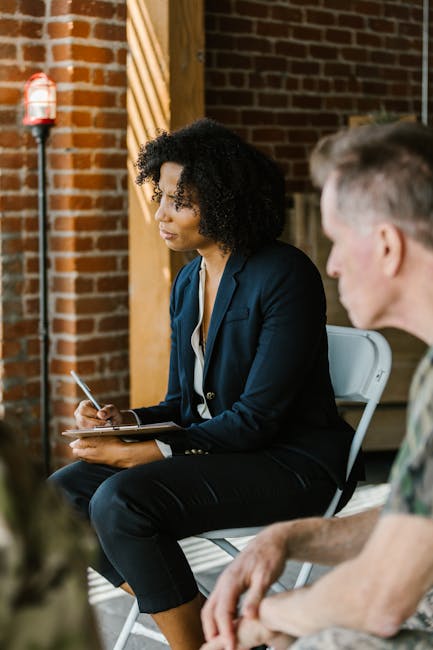In the realm of psychotherapy, communication serves as the bridge between the therapist and the client, paving the way for understanding, empathy, and ultimately, healing. This article delves into the significance of communication in psychotherapy, exploring its multifaceted role and how it contributes to the therapeutic process. Stick around to uncover the intricate dance of words, silence, and nonverbal cues that shape the therapeutic journey.
Key Takeaways
- Communication is the cornerstone of effective psychotherapy.
- Core communication skills include active listening, empathy, and nonverbal communication.
- Silence can be a powerful therapeutic tool when used appropriately.
- Various communication techniques aid in therapeutic progress.
- Therapists must manage communication challenges to maintain a productive therapeutic relationship.
- Nonverbal communication provides valuable insights into the client’s emotional state.
- Unconscious processes can be understood through communication.
- Building a strong therapeutic alliance relies heavily on effective communication.
Introduction to the Importance of Communication in Psychotherapy
Definition of communication in the therapeutic context
In psychotherapy, communication is not merely the exchange of words. It encompasses verbal exchanges, nonverbal cues, and even silence. It’s the vehicle through which therapists and clients navigate the therapeutic journey, fostering understanding, empathy, and trust.
Overview of communication’s role in therapy and counseling
Communication in therapy and counseling serves multiple purposes. It allows therapists to gather information, understand the client’s perspective, provide feedback, and facilitate change. It also helps build the therapeutic alliance, a crucial factor in successful therapy outcomes.

Core Communication Skills in Psychotherapy
Active Listening
Importance of fully understanding clients
Active listening is a fundamental skill in psychotherapy. It involves fully focusing on the client, understanding their message, and responding thoughtfully. This skill is vital in creating a safe and validating environment where clients feel heard and understood.
Techniques for demonstrating active listening
Active listening techniques include paraphrasing, reflecting feelings, summarizing, and asking open-ended questions. These techniques demonstrate the therapist’s engagement and facilitate deeper exploration of the client’s experiences.
Empathy
Conveying understanding of clients’ feelings
Empathy, the ability to understand and share the feelings of another, is a core component of therapeutic communication. It enables therapists to connect with clients on an emotional level, fostering a sense of validation and acceptance.
Impact on the therapeutic relationship
Empathy strengthens the therapeutic relationship, promoting trust and openness. It helps clients feel understood and less alone in their struggles, enhancing their motivation for change.
Nonverbal Communication
Interpreting body language and facial expressions
Nonverbal communication, such as body language and facial expressions, provides valuable insights into the client’s emotional state. Therapists must be adept at reading these cues to fully understand their clients.
Enhancing verbal communication with nonverbal cues
Nonverbal cues can enhance verbal communication, adding depth and nuance to the spoken words. They can also signal emotions or thoughts that the client may not be able to articulate verbally.

The Therapeutic Use of Silence
Silence as a Reflective Tool
Encouraging client self-exploration
Silence can be a powerful tool in therapy, providing space for clients to reflect and explore their thoughts and feelings. It can encourage self-exploration and facilitate deeper insight.
Allowing space for emotional processing
Silence also allows space for emotional processing. It can provide a respite from the intensity of verbal exchanges, giving clients time to process their emotions and reactions.
Timing and Impact of Silence
Strategic use in psychodynamic psychotherapy
In psychodynamic psychotherapy, silence can be used strategically to explore unconscious processes and relational dynamics. It can provoke reflection and insight, facilitating deeper understanding of the self.
Balancing silence with verbal interventions
However, silence must be balanced with verbal interventions. Too much silence can create discomfort or confusion, while too little may hinder reflection and insight.

Communication Techniques for Therapeutic Progress
Summarizing and Reflecting
Ensuring clients feel heard
Summarizing and reflecting are essential communication techniques in therapy. They ensure that clients feel heard and understood, reinforcing the therapeutic alliance.
Reinforcing understanding of clients’ narratives
These techniques also reinforce the therapist’s understanding of the client’s narrative, helping to clarify and explore themes and patterns.
Clarifying and Questioning
Resolving ambiguities in communication
Clarifying and questioning are used to resolve ambiguities and deepen understanding. They encourage clients to explore their thoughts and feelings more deeply, promoting insight and self-awareness.
Encouraging deeper client insight
By prompting clients to elaborate or explain, therapists can facilitate deeper insight and understanding. This can aid in the therapeutic process, promoting change and growth.
Validating Clients’ Experiences
Establishing trust through affirmation
Validation is a crucial aspect of therapeutic communication. It involves affirming the client’s experiences and emotions, fostering trust and openness.
Strengthening the therapeutic alliance
Validation strengthens the therapeutic alliance, promoting client engagement and disclosure. It reassures clients that their experiences are valid and important, enhancing their motivation for therapy.

Managing Communication Challenges in Therapy
Resolving Misunderstandings
Techniques for addressing and preventing conflicts
Misunderstandings can arise in therapy, potentially hindering progress. Therapists must be skilled in resolving these conflicts, using techniques such as clarification, reflection, and feedback.
Importance of therapist self-awareness
Therapist self-awareness is crucial in managing communication challenges. Therapists must be aware of their own biases, reactions, and communication patterns to effectively navigate the therapeutic relationship.
Therapist Communication Patterns
Influence on client openness
The therapist’s communication style can significantly influence the client’s openness and engagement in therapy. A supportive, empathetic, and nonjudgmental approach can foster a safe environment where clients feel comfortable sharing their experiences.
Adjusting communication style to client needs
Therapists must also be flexible, adjusting their communication style to meet the client’s needs. This can enhance the therapeutic process, promoting client engagement and therapeutic progress.

Nonverbal Communication and Its Interpretation
Reading Nonverbal Cues
Assessing emotional states
Nonverbal cues can provide valuable insights into the client’s emotional state. Therapists must be skilled in reading these cues to fully understand their clients.
Gauging readiness for therapy
Nonverbal communication can also help gauge the client’s readiness for therapy. For instance, body language and facial expressions can indicate resistance, discomfort, or engagement.
Integrating Nonverbal Insights
Complementing verbal communication
Nonverbal insights can complement verbal communication, adding depth and nuance to the therapeutic dialogue. They can signal emotions or thoughts that the client may not be able to articulate verbally.
Adjusting therapeutic approaches
By integrating nonverbal insights, therapists can adjust their therapeutic approaches to better meet the client’s needs. This can enhance the therapeutic process, promoting client engagement and therapeutic progress.

Understanding Unconscious Processes Through Communication
Communicating Insight into Unconscious Behaviors
Role in psychodynamic psychotherapy
In psychodynamic psychotherapy, communication plays a crucial role in exploring unconscious processes. Therapists use verbal and nonverbal cues to gain insight into unconscious behaviors and patterns.
Facilitating client self-awareness
By communicating these insights, therapists can facilitate client self-awareness. This can promote insight and understanding, aiding in the therapeutic process.
Interpretation of Transference and Countertransference
Communicating understanding of relational dynamics
Transference and countertransference are key concepts in psychotherapy, reflecting the relational dynamics between the therapist and the client. Therapists must be skilled in interpreting and communicating these dynamics to facilitate therapeutic progress.
Using the therapeutic relationship as a tool for insight
The therapeutic relationship itself can be a tool for insight. By exploring the dynamics of this relationship, therapists can help clients gain insight into their relational patterns and behaviors.
Building the Therapeutic Alliance with Communication
Empathy and Trust as Foundations
Role in establishing a safe therapeutic environment
Empathy and trust are foundational to the therapeutic alliance. Through effective communication, therapists can foster a safe and validating environment where clients feel comfortable exploring their thoughts and feelings.
Impact on client engagement and disclosure
Empathy and trust also impact client engagement and disclosure. Clients who feel understood and validated are more likely to engage in therapy and disclose their experiences, enhancing the therapeutic process.
Communication as a Predictor of Success
Correlation with therapeutic outcomes
Research has shown a strong correlation between effective communication and positive therapeutic outcomes. Therapists who communicate effectively are more likely to build strong therapeutic alliances, promoting client engagement and therapeutic progress.
Continuous development of communication skills by therapists
Given the importance of communication in psychotherapy, therapists must continuously develop their communication skills. This includes active listening, empathy, nonverbal communication, and managing communication challenges.

Conclusion
Recap of Communication’s Role in Effective Psychotherapy
Communication plays a pivotal role in effective psychotherapy. It facilitates understanding, empathy, and trust, fostering a strong therapeutic alliance. It also aids in the exploration of thoughts, feelings, and unconscious processes, promoting insight and therapeutic progress.
Final Thoughts on the Continuous Improvement of Therapeutic Communication Skills
The importance of communication in psychotherapy underscores the need for therapists to continuously hone their communication skills. As they navigate the therapeutic journey with their clients, effective communication serves as their compass, guiding them towards understanding, empathy, and healing.
For more insights into the world of psychotherapy, check out our articles on counseling and therapy, interpersonal therapy, and problem-solving therapy. To understand the broader context of psychotherapy, explore our resources on social psychology and mental health awareness.
Sources:
– Positive Psychology
– AIPC Article Library
– PubMed
Unlocking the Mysteries of the Mind: Your FAQ Guide to the Importance of Communication in Psychotherapy
Why is communication considered key in psychotherapy?
Communication is the cornerstone of psychotherapy as it facilitates the understanding and resolution of a client’s issues. It allows therapists to gather essential information about the client’s thoughts, feelings, and behaviors, and helps build a therapeutic alliance. Effective communication can lead to breakthroughs in treatment, as clients feel heard and understood, which is crucial for their healing process.
How does good communication affect the therapist-client relationship?
Good communication fosters trust and rapport, which are vital components of the therapist-client relationship. When clients feel comfortable sharing their innermost thoughts and feelings, it creates a safe space for them to explore and address their concerns. This strong therapeutic alliance improves treatment adherence and outcomes, as clients are more likely to be open and engaged throughout the process.
Can poor communication hinder psychotherapy progress?
Yes, poor communication can significantly hinder progress in psychotherapy. Misunderstandings, unmet expectations, and feelings of not being understood can lead to frustration and resistance from the client. It can also result in a weak therapeutic alliance, making it difficult to achieve the goals of therapy. Therefore, therapists must be skilled communicators to avoid these pitfalls.
What role does non-verbal communication play in psychotherapy?
Non-verbal communication, such as body language, facial expressions, and tone of voice, plays a critical role in psychotherapy. It can provide clues to a client’s emotional state and unspoken thoughts, which might not be revealed through words alone. Therapists use these cues to gain a deeper understanding of their clients and to check for congruence between what is said and what is expressed non-verbally.
How can clients improve their communication skills in therapy?
Clients can improve their communication skills in therapy by being open and honest with their feelings, asking questions when they need clarification, and providing feedback to their therapist about the therapy process. Practicing active listening and reflecting on their thoughts before speaking can also enhance the communication experience in therapy sessions.
What techniques do therapists use to improve communication during sessions?
Therapists use a variety of techniques to improve communication, such as active listening, reflective statements, open-ended questions, and summarizing what the client has said to ensure understanding. They also create a non-judgmental environment that encourages clients to express themselves freely without fear of criticism or rejection.
Is communication in psychotherapy different from everyday communication?
Yes, communication in psychotherapy is often more structured and intentional than everyday communication. Therapists are trained to listen actively and to respond in ways that promote insight and self-awareness. The language used is typically more empathetic and supportive, aimed at facilitating personal growth and healing.
How does cultural background influence communication in therapy?
Cultural background can significantly influence communication styles, values, and expectations in therapy. Therapists must be culturally competent and sensitive to these differences to avoid misunderstandings and to provide effective treatment. They should be aware of cultural norms and non-verbal cues specific to the client’s background and adapt their communication style accordingly.
What is the importance of confidentiality in communication during psychotherapy?
Confidentiality is paramount in psychotherapy as it ensures that the information shared by the client remains private. This assurance of privacy is essential for building trust and encourages clients to communicate openly without fear of exposure. Therapists are bound by ethical codes and laws to protect client confidentiality, with few exceptions related to safety concerns.
Can communication in psychotherapy be improved through technology, such as teletherapy?
Technology, such as teletherapy, can enhance communication in psychotherapy by providing greater accessibility and convenience for clients. It allows for therapy sessions to occur via video conferencing, phone calls, or messaging, which can be particularly beneficial for those with mobility issues or in remote areas. However, therapists must be mindful of maintaining the same level of empathy and active listening as they would in face-to-face sessions.



